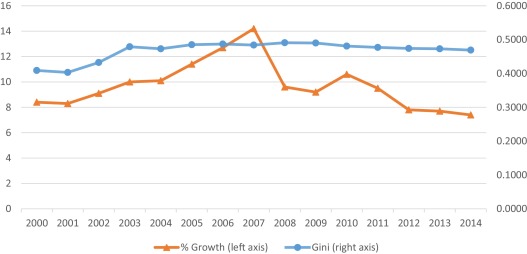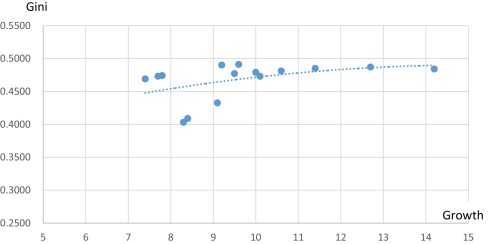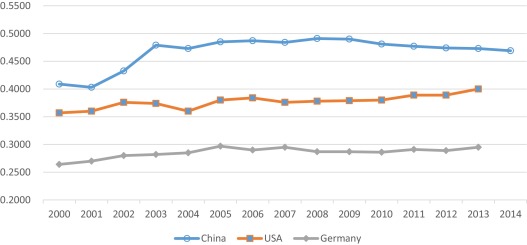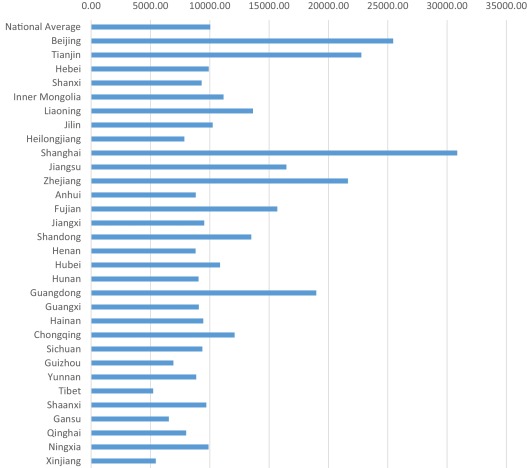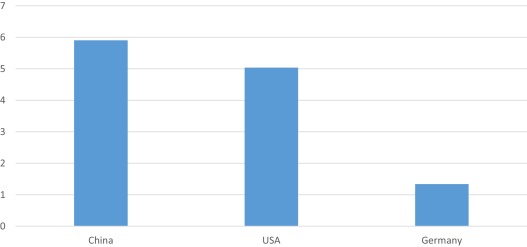Summary
There have been many papers recently (both theoretical and empirical) analyzing the problem of income inequality in China. Most of them usually state that the income inequality in China is growing in two dimensions – among the regions and between the urban and rural areas. Moreover, an opinion that reducing the inequality must be connected with sacrificing some part of economic growth prevails. These results seem to be widely accepted also by the media and politicians.
In this paper we provide evidence that the income inequality remains stable in last years and that its relationship with economic growth is very ambiguous. Using the comparison with some other countries, we document that the inequality in both dimensions mentioned above does not change significantly faster than in other countries.
Keywords
China ; Inequality ; Gini coefficient ; Economic growth
Introduction
Since the late 1970s, Peoples Republic of China experienced the period of dramatic economic development. Growth of GDP, followed with increased disposable income and living standards was accompanied with significant changes in inequality of both income and wealth. These changes appear especially in two dimensions – among the regions and between rural and urban areas. There is a widely accepted opinion that the extent of income disparities is positively correlated with economic growth. Thus, China faces a choice. Either it has to face all the negative consequences of income inequality, or it has to sacrifice some part of its growth to reduce the inequality.
The goal of this paper is to document the recent trends in Chinese income inequality. As there are many studies in the literature focusing on older data or longer time series (see for example Chen and Lu (2009) , Sicular et al. (2007) and studies mentioned in following text), we focus mainly on the recent data (2000–2014 series). The structure of the paper is as follows. First, we focus on the development of income inequalities in China from the late 1970s, its probable causes and consequences. Then, we briefly examine the relationship between economic growth and inequality. The survey of empirical literature on this topic is also provided, then possible alternative outcomes for China are discussed. Following part of this paper is dedicated to international comparison (mainly with the United States) of main inequality indicators. In the end, we provide the conclusions and discuss possible recommendation of further policies to reduce the inequality.
Chinas disparities – a historical overview
Discussing the evolution of income inequalities in China, its post war history can be divided into several phases. The land reforms after the revolution (1949–56) were followed by so called “Great Leap Forward”. However, this period of economic growth was broken by the Great Famine (1959–61). After the post-famine recovery in first half of 1960s, the period of several reforms appeared – the cultural revolution and transition to reforms (1966–78), the rural reforms (1979–84) and the post-rural reform connected with the governance reform and opening up to trade (after 1985). Although this paper focuses mainly on the period 2000 and after, it is beneficial to briefly comment the previous phases of Chinese economic development.
First peak of inequality – the Great Famine
During the initial period of land reform, Chinese government set the fastening of industrialization process as one of its main goals. Redistribution of resources from agriculture to heavy industry was followed with restrictions of labour-mobility and decreasing of agricultural prices. In 1958, government introduced the Hukou1 system of households’ registration. Strategy of promoting the urban population and putting most of the resources to heavy industry helped the economy to face the “Great Leap Forward”, but was broken by the Great Famine in 1959–1961. This period was characterized by a huge increase of inequality in China, as the Gini coefficient increased from 0.235 in 1955 to 0.326 in 1960. Most of the economists agree that the main cause of this increase was the dramatic increase of disparities in income distribution between urban and rural areas. Fan et al. (2011) calculated the difference between the rural and urban component of Gini coefficient in 1955 as 0.066, while this value more than doubled in 1960. Similar values were obtained by Kanbur and Zhang (2005) .
Changes after cultural reform and results of openness strategy
In the second half of 70s, government shifted its support to agriculture and other labour-intensive sectors. The rural reform, increasing the farmers’ rights, led to a dramatic increase of agriculture production. Growing incomes of agriculture workers decreased the inequality substantially – the total Gini coefficient, as well as its urban–rural and inland–coastal components reached their minimum in the half of the 80s as a result of the mentioned policies.
Since 1985, the income inequality started to rise continuously. Government strategy, promoting the openness to the rest of the world, led to the massive development of the areas oriented to the export – especially Beijing and the coastal areas. Boom of coastal areas was also strengthened by the division of central government of investment, as this investment to coastal areas exceeded the sum of investment to central and western areas together between 1999 and 2005 (Fan et al., 2011 ).
Inequality measured by the Gini coefficient was rising on till the year 2008. Since that, the Gini coefficient values are slightly declining as a result of new government policies. Central government realized the inequality (both in rural–urban and inland–coastal dimension) as a serious problem and introduced new policies and reforms to decrease it.
As mentioned above, Chinese inequality is mainly determined by the regional and urban–rural disparities. Chinese central government applied both universal and selective measures for their reduction. Implementation of the system of minimum wage, fighting against corruption and higher pressure on administrative efficiency can be named as the examples of universal measures. Selectively, the “SanNong” strategy made the issues of agriculture, rural development and farmers the top concerns and priorities recently. Since January 1, 2006, China government has abolished the agricultural tax regulations, it also relaxes the restriction of the Hukou from this year. Also the share of transfers from the central government to rural increased. From the regional aspects’ point of view, major infrastructure construction projects were launched to support the development of the Midwest and the regions were given the policies to increase the openness. All these policies contributed to the reduction of income disparities.
Growth and income inequality – is there a relationship?
One of the most widely accepted stylized facts (both by researchers and politicians) is that Chinese inequality is (at least in the short run) closely related to the economic growth. Assuming that, Chinese government faces a dilemma of either accepting quite high level of inequality, or sacrificing some part of economic growth to reduce it. This opinion is based on Kuznets “reverse U hypothesis”, stating that growing per-capita income leads first to an increased inequality (mainly due to the investment and human capital of high income groups) and then starts to decline when the returns from investment diminish and migration occurs (Fig. 1 ).2
|
|
|
Figure 1. Development of Chinese inequality and growth (2000–2014 period). Source : OECD, National Bureau of Statistics of PRC. |
It is clearly visible that the inequality measured by the Gini coefficient3 remains quite stable in last ten years, while the economic growth fluctuated significantly. Correlation between income inequality and economic growth is positive, but very weak (0.0064), as shown in Fig. 2 .
|
|
|
Figure 2. Correlation of Chinese inequality and GDP growth (2000–2014 period). Source : OECD, National Bureau of Statistics of PRC. |
Serious questions appear here. Did the income inequality in China reach its limits? Is the stable (or slowly decreasing) inequality a result of government policies adopted recently? Can it be taken as a long-run trend? And the main question – if we admit the relationship between these two variables, what is the causality? Answer to this question is crucial for the policymakers. If decreasing the inequality becomes the main goal, can we achieve it THROUGH reducing economic growth (restrictive policies required), or will the economic slowdown be a CONSEQUENCE of reducing inequality (expansionary policy required)?
If we return back to Kuznets, we can easily use his theory for the explanation of the data. Although he examined the causality from growth to inequality, we still must take into account that he examined the relation between inequality and phase of economic development and not the levels of GDP growth. This can lead to the result that China reached the critical point of development and future growth (slower or faster) will lead to inequality decrease.
Other approaches can be also found in the literature. Bagliano and Bertola (2004) or Qin et al. (2009) examined the effects of inequality on economic growth and found serious negative relationship. Chen (2010) tested the relation between growth and inequality in both directions. He found that while the effects of inequality reduction are different in the short and long run, the effects of growth on inequality are the same (negative) no matter of time horizon. Lundberg and Squire (2003) concluded that there is no direct link between growth and inequality. Contrary, they are a common outcome of other processes and variables in the economy. For further literature review see Chen (2010) .
International comparison
Inequality in China is widely accepted as a serious problem, which becomes worse each year. However, if we compare the values of Gini coefficients of China and two other countries, that are commonly accepted as the most developed economies (USA and China), the picture becomes not so unambiguous (Fig. 3 ).
|
|
|
Figure 3. Gini coefficients in China, USA and Germany (2000–2014 period). Source : OECD, National Bureau of Statistics of PRC. |
It is obvious that the inequality in China is very high, compared to the other countries. However, if we exclude the start of the millennium, connected with a huge hike of Gini coefficient, the trend in Chinese income inequality is remaining stable or slightly decreasing recently. Both Germany and especially USA are facing an increase of Gini coefficients. It seems that recent Chinese policies are successful in decreasing inequality, but there is a question if they are also efficient. Most of those policies require lots of financial resources and Chinese debt (both private and public) become another serious issue in China.
The regional dimension
As mentioned above, disparities among regions in China contribute significantly to the total values of Gini coefficient. Focusing on regional differences can help the central government to influence the inequality in whole China. Gross disposable income per capita in the richest province (Shanghai) exceeds the value of Tibet almost 6 times, as seen in Fig. 4 .
|
|
|
Figure 4. Per capita gross disposable income of Chinese provinces (CNY, 2012). Source : National Bureau of Statistics of PRC. |
The differences are extremely high. However, this data can show significant bias. Li and Gibson (2013) argue that the system of evidence based on Hukou system creates a bias in all per capita variables (GDP, GDI, etc.) in the way that overestimates the values for rich provinces and underestimates the values for poor provinces. As all the data are based on the official registration, there are many inhabitants who live and earn their incomes in rich, mainly coastal provinces, although they are still registered as inhabitants of rural parts of inland provinces. Thus, both regional and urban/rural inequality measures based on per capita variables are overestimated. Moreover, as the reforms in registration systems are not implemented in all provinces at the same time, problems with double counts appear and bias the data even more.
Lets turn the attention back to the international comparison. Fig. 5 shows the inequality ratio (measured as the per capita gross disposable income of the richest region divided by the GDI of the poorest region).
|
|
|
Figure 5. Regional inequality in China, USA and Germany (year 2013). Source : National Bureau of Statistics of PRC, Statistical Office of Germany, Bureau of Economic Analysis. |
Chinese ratio (Shanghai and Tibet included) is very similar to the value of United States.4 On the other hand Germany shows very low inequality ratio, although it still faces the consequences of merging relatively poor East and very rich West Germany.
Conclusion
Income inequalities are still a real problem in China. It negatively influences the economic growth, increases the pressure on high social transfer payments and can be also a potential source of social disturbances. However, the situation is not as bad as is usually presented by media or some economists. Chinese inequality measured by Gini coefficient slightly declines for last 10 years, although China faces solid economic growth.
Recently adopted government reforms seem to be successful in reducing income disparities, although this goal still remains as secondary one. The data show that there is no strong relationship between growth and inequality, but if such relation exists, government will probably focus still on growth as the main objective of central government. As most of the studies conclude that inequality affects growth negatively in the long run, government should keep their effort in reforms, although the results will appear lately. As we documented, the regional aspect of income inequality in China is very strong, but not as dominant as it is usually considered. Thus, government should focus on policies which are more universal then selective for poor regions – fighting with bureaucracy, implementing the education reform, supporting efficiency of taxation and public governance generally. These policies, if correctly applied, do not put the burden on public finance while having long run positive effects.
Main data sources
- National Bureau of Statistics of PRC
- OECD Statistics Database
- Destatis – Federal Statistical Office of Germany
- Bureau of Economic Analysis
Conflict of interest
The authors declare that there is no conflict of interest.
Acknowledgements
This research was supported by the European Social Fund within the project CZ.1.07/2.3.00/20.0296 and within the project “Support of VŠB-TUO Activities with China” with the financial support from the Moravian-Silesian region.
References
- Bagliano and Bertola, 2004 F.-C. Bagliano, G. Bertola; Models for Dynamic Macroeconomics; Oxford University Press, Oxford (2004)
- Chen, 2010 A. Chen; Reducing Chinas regional disparities: is there a growth cost?; China Econ. Rev., 21 (2010), pp. 2–13
- Chen and Lu, 2009 Z. Chen, M. Lu; Is China sacrificing growth when balancing interregional and urban–rural development?; Y. Huang, A.M. Bocchi (Eds.), Reshaping Economic Geography in East Asia, The World Bank, Washington, DC (2009), pp. 241–257
- Fan et al., 2011 S. Fan, R. Kanbur, X. Zhang; Chinass regional disparities: experience and policy; Rev. Dev. Financ., 1 (2011), pp. 47–56
- Kanbur and Zhang, 2005 R. Kanbur, X. Zhang; Fifty years of regional inequality in China: a journey through central planning, reform, and openness; Rev. Dev. Econ., 9 (1) (2005), pp. 87–106
- Kuznets, 1955 S. Kuznets; Economic growth and income inequality; Am. Econ. Rev., 45 (1) (1955), pp. 1–28
- Li and Gibson, 2013 C. Li, J. Gibson; Rising regional inequality in China: fact or artifact?; World Dev., 47 (2013), pp. 16–29
- Lundberg and Squire, 2003 M. Lundberg, L. Squire; The simultaneous evolution of growth and inequality; Econ. J., 113 (2003), pp. 326–344
- Qin et al., 2009 D. Qin, M.A. Cagas, G. Ducanes, X. He, R. Liu, S. Liu; Effects of income inequality on Chinas economic growth; J. Policy Model., 31 (2009), pp. 69–86
- Sicular et al., 2007 T. Sicular, Y. Ximing, L. Shi; The urban–rural income gap and inequality in China; Rev. Income Wealth, 53 (1) (2007), pp. 93–126
Notes
1. Hukou is a term widely used in the public, although “Huji” system is more precise and correct term. It confined the individuals to a municipality of their birth to ensure that there was enough work force to produce sufficient grain for the urban population.
2. See Kuznets (1955) for further details.
3. Standard Gini coefficient is based on the formula G = (2covar (y , ry ))/ny , where y is an income, ry is the correlation coefficient between income and the series of all individuals sorted from poorest to richest and is the mean income. We adopted it for further comparison as the most common measure of income inequality. Several other measures can be chosen, their comprehensive list and discussion of their properties can be found in Qin et al. (2009) .
4. The US value includes the ratio between District of Columbia and Mississippi. If we exclude the DC, as it is not a standard federal state, and use Delaware instead, the ratio drops down dramatically (to 2,3). German value includes the per capita GDI of Bayern related to Mecklenburg-Verpommern.
Document information
Published on 05/10/16
Licence: Other
Share this document
Keywords
claim authorship
Are you one of the authors of this document?
